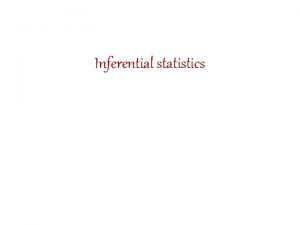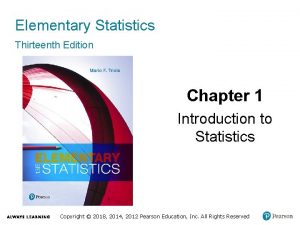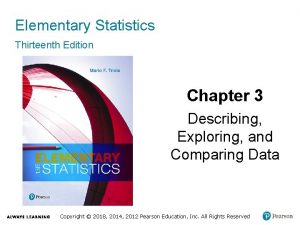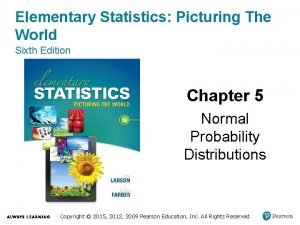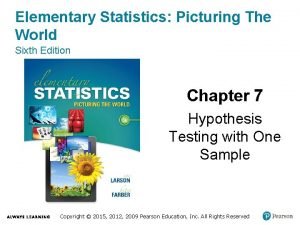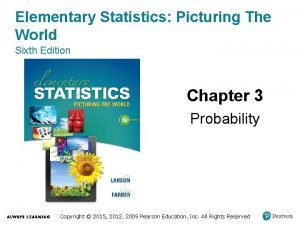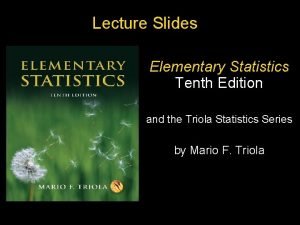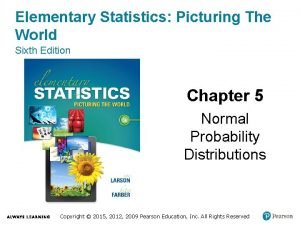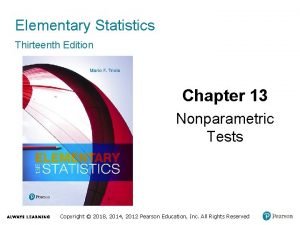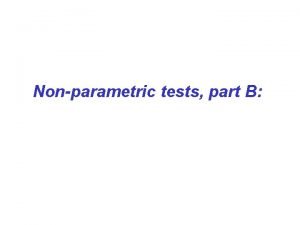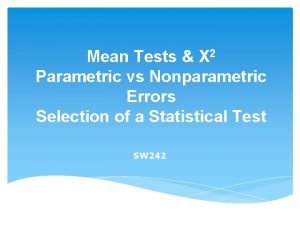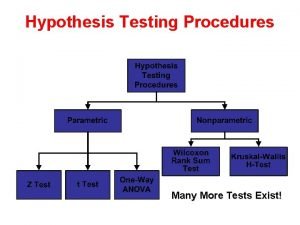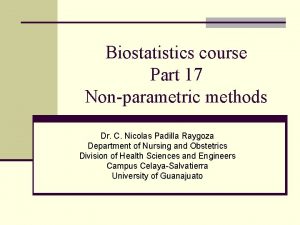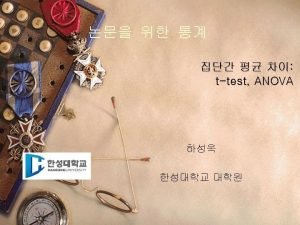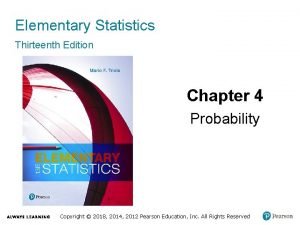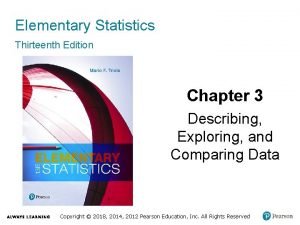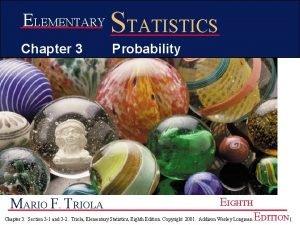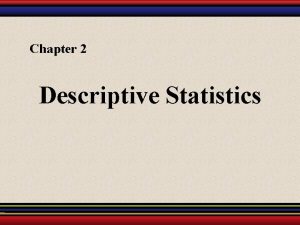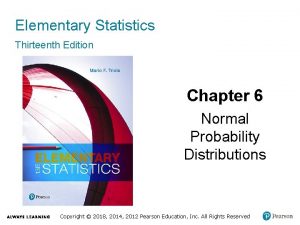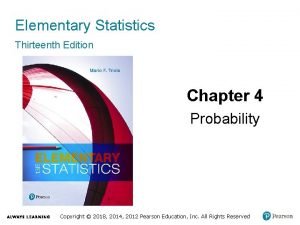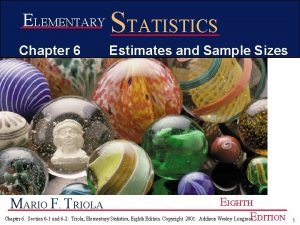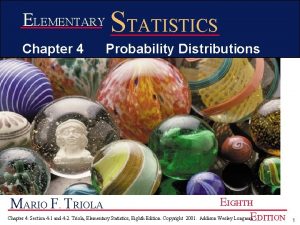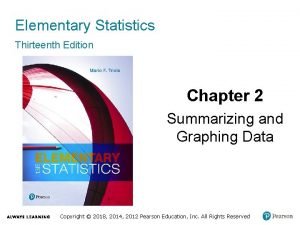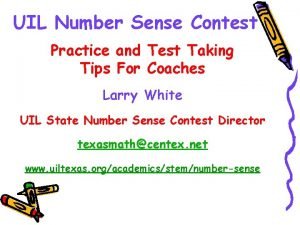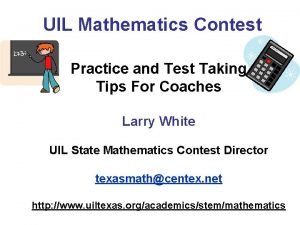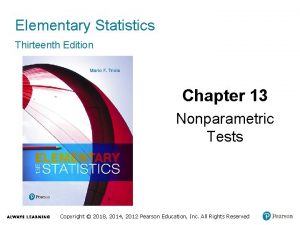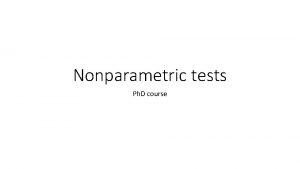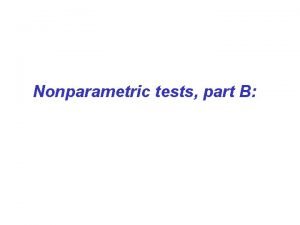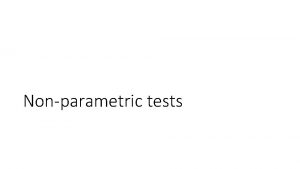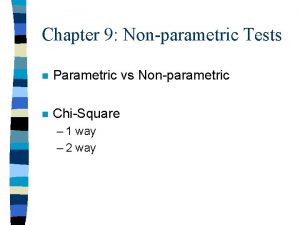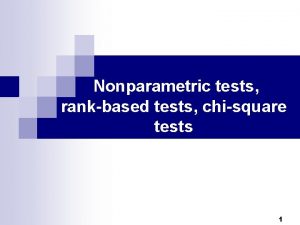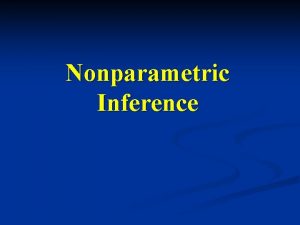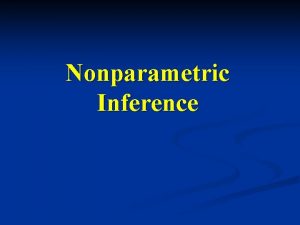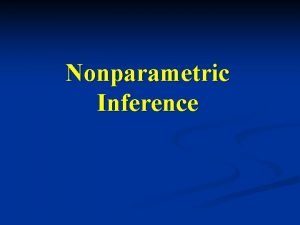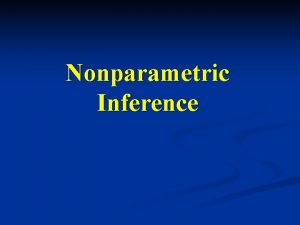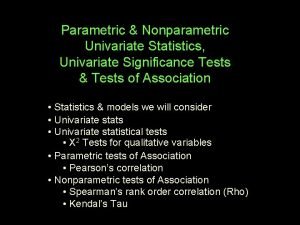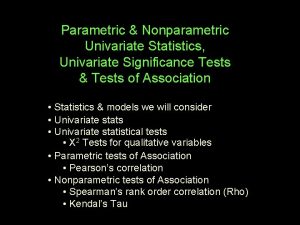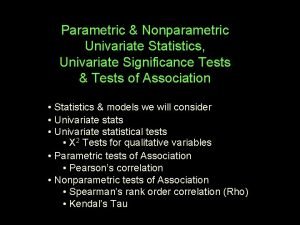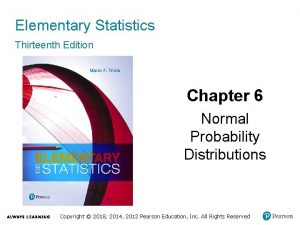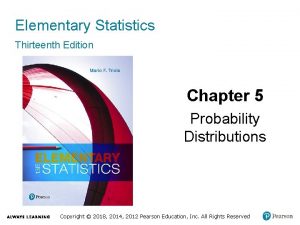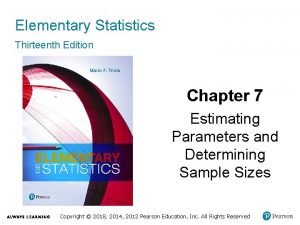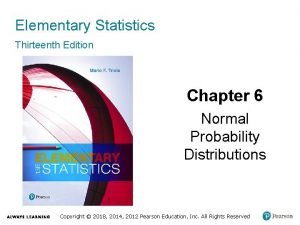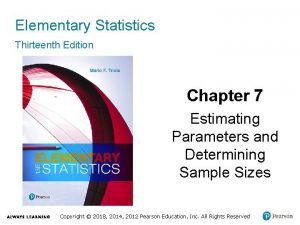Elementary Statistics Thirteenth Edition Chapter 13 Nonparametric Tests


























- Slides: 26

Elementary Statistics Thirteenth Edition Chapter 13 Nonparametric Tests Copyright © 2018, 2014, 2012 Pearson Education, Inc. All Rights Reserved

Nonparametric Tests 13 -1 Basics of Nonparametric Tests 13 -2 Sign Test 13 -3 Wilcoxon Signed-Ranks Test for Matched Pairs 13 -4 Wilcoxon Rank-Sum Test for Two Independent Samples 13 -5 Kruskal-Wallis Test for Three or More Samples 13 -6 Rank Correlation 13 -7 Runs Test for Randomness Copyright © 2018, 2014, 2012 Pearson Education, Inc. All Rights Reserved

Key Concept This section describes the nonparametric method of the rank correlation test, which uses ranks of paired data to test for an association between two variables. Copyright © 2018, 2014, 2012 Pearson Education, Inc. All Rights Reserved

Rank Correlation Test • Rank Correlation Test – The rank correlation test (or Spearman’s rank correlation test) is a nonparametric test that uses ranks of sample data consisting of matched pairs. It is used to test for an association between two variables. Copyright © 2018, 2014, 2012 Pearson Education, Inc. All Rights Reserved

Rank Correlation: Objective Compute the rank correlation coefficient rs and use it to test for an association between two variables. The null and alternative hypotheses are as follows: Copyright © 2018, 2014, 2012 Pearson Education, Inc. All Rights Reserved

Rank Correlation: Notation rs = rank correlation coefficient for sample paired data (rs is a sample statistic) n = number of pairs of sample data d = difference between ranks for the two values within an individual pair Copyright © 2018, 2014, 2012 Pearson Education, Inc. All Rights Reserved

Rank Correlation: Requirements 1. The paired data are a simple random sample. 2. The data are ranks or can be converted to ranks. Copyright © 2018, 2014, 2012 Pearson Education, Inc. All Rights Reserved

Rank Correlation: Test Statistic (1 of 2) Within each sample, first convert the data to ranks, then find the exact value of the rank correlation coefficient rs by using this formula: Copyright © 2018, 2014, 2012 Pearson Education, Inc. All Rights Reserved

Rank Correlation: Test Statistic (2 of 2) Simpler Test Statistic if There Are No Ties: After converting the data in each sample to ranks, if there are no ties among ranks for the first variable and there are no ties among ranks for the second variable, the exact value of the test statistic can be calculated using the formula on the previous slide or with the following relatively simple formula, but it is probably easier to use the formula on the previous slide with technology: Copyright © 2018, 2014, 2012 Pearson Education, Inc. All Rights Reserved

Rank Correlation: P-Values P-values are sometimes provided by technology, but use them only if they result from Spearman’s rank correlation. (Do not use P-values resulting from tests of linear correlation. ) Copyright © 2018, 2014, 2012 Pearson Education, Inc. All Rights Reserved

Rank Correlation: Critical Values 1. If n ≤ 30, critical values are found in Table A-9. 2. If n > 30, critical values of rs are found using the following formula. where the value of z corresponds to the significance level. Copyright © 2018, 2014, 2012 Pearson Education, Inc. All Rights Reserved

Rank Correlation Procedure for Testing H 0: ρs = 0 Copyright © 2018, 2014, 2012 Pearson Education, Inc. All Rights Reserved

Advantages of Rank Correlation Rank correlation has these advantages over the parametric methods: 1. Rank correlation can be used with paired data that are ranks or can be converted to ranks. Unlike the parametric methods, the method of rank correlation does not require a normal distribution for any population. 2. Rank correlation can be used to detect some (not all) relationships that are not linear. Copyright © 2018, 2014, 2012 Pearson Education, Inc. All Rights Reserved

Disadvantage of Rank Correlation: Efficiency A minor disadvantage of rank correlation is its efficiency rating of 0. 91. This efficiency rating shows that with all other circumstances being equal, the nonparametric approach of rank correlation requires 100 pairs of sample data to achieve the same results as only 91 pairs of sample observations analyzed through the parametric approach, assuming that the stricter requirements of the parametric approach are met. Copyright © 2018, 2014, 2012 Pearson Education, Inc. All Rights Reserved

Example: Do Better Televisions Cost More? (1 of 8) The table below lists ranks and costs (hundreds of dollars) of LCD televisions with screens of at least 60 inches (based on data from Consumer Reports). Find the value of the rank correlation coefficient and use it to determine whethere is sufficient evidence to support the claim of a correlation between quality and price. Use a 0. 05 significance level. Based on the result, does it appear that you can get better quality by spending more? Quality Rank 1 2 3 4 5 6 7 8 9 10 Cost (hundreds of dollars) 23 50 23 20 32 25 14 16 40 22 Copyright © 2018, 2014, 2012 Pearson Education, Inc. All Rights Reserved

Example: Do Better Televisions Cost More? (2 of 8) Solution Requirement Check The sample data are a simple random sample from the televisions that were tested. The data are ranks or can be converted to ranks. The quality ranks are consecutive integers and are not from a population that is normally distributed, so we use the rank correlation coefficient to test for a relationship between quality and price. Copyright © 2018, 2014, 2012 Pearson Education, Inc. All Rights Reserved

Example: Do Better Televisions Cost More? (3 of 8) Copyright © 2018, 2014, 2012 Pearson Education, Inc. All Rights Reserved

Example: Do Better Televisions Cost More? (4 of 8) Solution Following the procedure, we begin by converting the costs in the table below into their corresponding ranks shown in the table on the next slide. Quality Rank 1 2 3 4 5 6 7 8 9 10 Cost (hundreds of dollars) 23 50 23 20 32 25 14 16 40 22 Copyright © 2018, 2014, 2012 Pearson Education, Inc. All Rights Reserved

Example: Do Better Televisions Cost More? (5 of 8) Solution The lowest cost of $1400 is assigned a rank of 1. Because the fifth and sixth costs are tied at $2300, we assign the rank of 5. 5 to each of them (where 5. 5 is the mean of ranks 5 and 6). The ranks corresponding to the costs are shown in the second row. Quality Rank Cost Rank 1 2 3 4 5 6 7 8 9 10 5. 5 3 8 7 1 2 9 4 Copyright © 2018, 2014, 2012 Pearson Education, Inc. All Rights Reserved

Example: Do Better Televisions Cost More? (6 of 8) Solution Because there are ties among ranks, we must use the first test statistic formula to find that the rank correlation coefficient rs is equal to − 0. 274. Quality Rank Cost Rank 1 2 3 4 5 6 7 8 9 10 5. 5 3 8 7 1 2 9 4 Copyright © 2018, 2014, 2012 Pearson Education, Inc. All Rights Reserved

Example: Do Better Televisions Cost More? (7 of 8) Solution Copyright © 2018, 2014, 2012 Pearson Education, Inc. All Rights Reserved

Example: Do Better Televisions Cost More? (8 of 8) Solution Now we refer to Table A-9 to find the critical values of ± 0. 648 (based on α = 0. 05 and n = 10). Because the test statistic rs = − 0. 274 is between the critical values of − 0. 648 and 0. 648, we fail to reject the null hypothesis. There is not sufficient evidence to support a claim of a correlation between quality and cost. Based on the given sample data, it appears that you don’t necessarily get better quality by paying more. Copyright © 2018, 2014, 2012 Pearson Education, Inc. All Rights Reserved

Example: Large Sample Case (1 of 4) Refer to the measured systolic and diastolic blood pressure measurements of 147 randomly selected females in Data Set 1 “Body Data” in Appendix B and use a 0. 05 significance level to test the claim that among women, there is a correlation between systolic blood pressure and diastolic blood pressure. Copyright © 2018, 2014, 2012 Pearson Education, Inc. All Rights Reserved

Example: Large Sample Case (2 of 4) Solution Requirement Check The data are a simple random sample and can be converted to ranks. Test Statistic The value of the rank correlation coefficient is rs = 0. 354, which can be found by using technology. Copyright © 2018, 2014, 2012 Pearson Education, Inc. All Rights Reserved

Example: Large Sample Case (3 of 4) Solution Critical Values Because there are 147 pairs of data, we have n = 147. Because n exceeds 30, we find the critical values from the formula below instead of Table A-9. With α = 0. 05 in two tails, we let z = 1. 96 to get the critical values of − 0. 162 and 0. 162, as shown below. Copyright © 2018, 2014, 2012 Pearson Education, Inc. All Rights Reserved

Example: Large Sample Case (4 of 4) Solution The test statistic of rs = 0. 354 is not between the critical values of − 0. 162 and 0. 162, so we reject the null hypothesis of rs = 0. There is sufficient evidence to support the claim that among women, there is a correlation between systolic blood pressure and diastolic blood pressure. Copyright © 2018, 2014, 2012 Pearson Education, Inc. All Rights Reserved
 Nonparametric tests
Nonparametric tests Experimental hypothesis
Experimental hypothesis Elementary statistics 13th edition chapter 1
Elementary statistics 13th edition chapter 1 Elementary statistics 13th edition answers
Elementary statistics 13th edition answers Picturing distributions with graphs
Picturing distributions with graphs P value
P value Elementary statistics picturing the world 6th edition
Elementary statistics picturing the world 6th edition Elementary statistics tenth edition
Elementary statistics tenth edition Elementary statistics picturing the world 6th edition
Elementary statistics picturing the world 6th edition Elementary statistics 13th edition
Elementary statistics 13th edition Nonparametric test
Nonparametric test Parametric vs nonparametric test
Parametric vs nonparametric test Nonparametric test
Nonparametric test Nonparametric methods
Nonparametric methods Douwe postmus
Douwe postmus Ace different tests help iq but
Ace different tests help iq but Elementary statistics chapter 4
Elementary statistics chapter 4 Elementary statistics chapter 3
Elementary statistics chapter 3 What will be the probability of an impossible event
What will be the probability of an impossible event Elementary statistics larson farber
Elementary statistics larson farber Elementary statistics chapter 6
Elementary statistics chapter 6 Elementary statistics chapter 4
Elementary statistics chapter 4 Elementary statistics chapter 6
Elementary statistics chapter 6 Elementary statistics chapter 4
Elementary statistics chapter 4 Elementary statistics chapter 2
Elementary statistics chapter 2 Uil number sense rules
Uil number sense rules Uil math practice tests
Uil math practice tests

